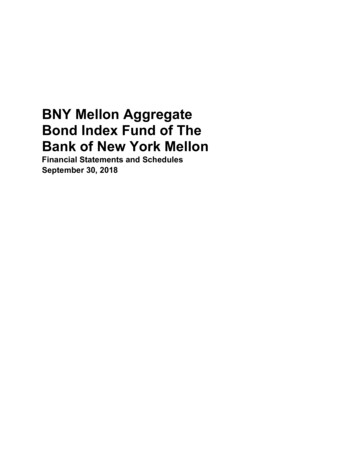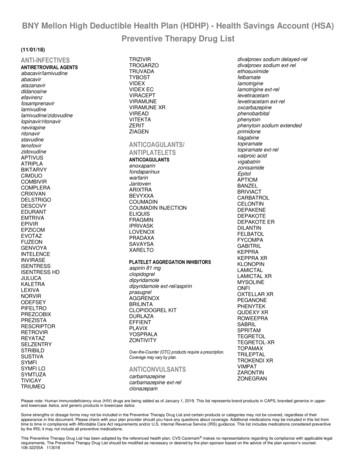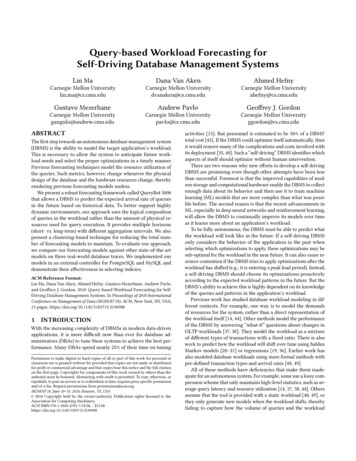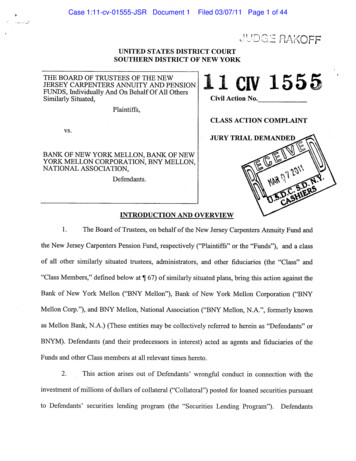
Transcription
BNY Mellon Resolution PlanPublic SectionJuly 1, 2014
Table of ContentsSection 1: Public Section . 3Introduction . 3Overview of BNY Mellon . 5A. Names of Material Entities . 7B. Description of Core Business Lines . 8C. Summary of Financial Information Regarding Assets, Liabilities, Capital and Major Funding Sources . 9D. Description of Derivative and Hedging Activities. 15E. Memberships in Material Payment, Clearing and Settlement Systems . 17F. Description of Foreign Operations . 18G. Material Supervisory Authorities . 19H. Principal Officers. 21I. Resolution Planning Corporate Governance Structure and Processes. 22J. Description of Material Management Information Systems . 23K. High-Level Description of Resolution Strategy . 242
Section 1: Public SectionIntroductionThis Public Section provides an overview of the overall resolution strategy for The Bank of New YorkMellon Corporation and its material entities, including its principal bank subsidiary, The Bank of NewYork Mellon. References to “our,” “we,” “us,” and “BNY Mellon,” refer to The Bank of New York MellonCorporation and its consolidated subsidiaries, while references to the “Parent” refer solely to The Bankof New York Mellon Corporation, the parent company.Title I, Section 165(d) of the Dodd-Frank Wall Street Reform and Consumer Protection Act (the “DoddFrank Act”) and implementing regulations issued by the Federal Deposit Insurance Corporation (the“FDIC”) and the Board of Governors of the Federal Reserve System (the “Federal Reserve”) require bankholding companies with assets of 50 billion or more, such as the Parent, to submit periodically to theFederal Reserve, the FDIC and the Financial Stability Oversight Council a plan for resolution in the eventof material distress or failure of the bank holding company. The FDIC has also issued a final rule thatrequires insured depository institutions with assets of 50 billion or more, such as The Bank of New YorkMellon, to submit periodically to the FDIC a plan for resolution in the event of failure under the FederalDeposit Insurance Act (the “FDI Act”). Accordingly, we have developed a resolution plan in conformitywith both rules (the “Resolution Plan”), including this Public Section which contains the informationrequired by the regulators to be made available publicly.BNY Mellon endorses the concept of resolution planning as a key element of risk management toprotect the soundness of the global financial system. We believe no firm should be “too big to fail” andthat, regardless of size, financial institutions should be able to be resolved without taxpayer or U.S.government support.BNY Mellon’s business model is primarily fee-based with no substantial exposure to credit risk. A largepercentage of our revenue—more than the median revenue of our peers—comes from recurring fees.This helps us maintain a strong, highly liquid balance sheet with a solid capital position and strong creditratings.In the unlikely event a resolution of BNY Mellon were necessary, there are several factors thatcontribute to the resolvability of BNY Mellon under the U.S. Bankruptcy Code and other applicableinsolvency regimes, including the facts that (i) the bulk of BNY Mellon’s core business lines and criticaloperations are conducted in The Bank of New York Mellon, which would allow the FDIC to use itstraditional resolution powers in receivership under the FDI Act to facilitate the orderly disposition orwind down of The Bank of New York Mellon, (ii) the core business lines and critical operationsconducted through non-bank entities of BNY Mellon are largely self-contained within separate legalentities, allowing for their rapid divestiture or orderly wind-down, if necessary, under the U.S.Bankruptcy Code, and (iii) our highly liquid balance sheet would allow us to withstand deposit run-offwithout systemic impact.3
The Resolution Plan sets out a detailed description of the resolution options for the Parent and each ofits material entities, including The Bank of New York Mellon, with a focus on ensuring their orderlyresolution in a manner that preserves value, ensures continuity of services, and avoids systemic risk tothe U.S. financial system. In each of the resolution strategies, depositors would have timely access totheir insured deposits and there would be no cost to the FDIC Deposit Insurance Fund.While BNY Mellon could similarly be resolved without systemic impact under the Orderly LiquidationAuthority of Title II of the Dodd-Frank Act, pursuant to which the FDIC is granted the power andauthority to resolve systemically important financial institutions in a manner analogous to the resolutionof failed insured depository institutions under the FDI Act, the Dodd-Frank Act implementing regulationsspecifically require the Resolution Plan to provide a strategic analysis of resolvability under the U.S.Bankruptcy Code and certain other applicable insolvency regimes. Accordingly, the Orderly LiquidationAuthority is outside the scope of the Resolution Plan.The information contained in the Resolution Plan, including this Public Section, has been prepared inaccordance with applicable regulatory requirements and guidance. Any differences in the presentation ofinformation concerning our businesses and operations contained herein relative to how BNY Mellonpresents such information for other purposes is solely due to our efforts to comply with the rulesgoverning the submission of resolution plans. The information presented herein, including thedesignation of “material entities” and “core business lines”, does not, in any way, reflect changes to ourorganizational structure, business practices or strategy.4
Overview of BNY MellonThe Bank of New York Mellon Corporation, a Delaware corporation (NYSE symbol: BK), is a globalinvestments company dedicated to helping its clients manage and service their financial assetsthroughout the investment lifecycle. Whether providing financial services for institutions, corporationsor individual investors, BNY Mellon delivers informed investment management and investment servicesin 35 countries and more than 100 markets.The Parent was formed as a bank holding company and has its executive offices in New York, New York.With its predecessors, BNY Mellon has been in business since 1784.We divide our businesses into two principal segments, Investment Management and InvestmentServices.Our Investment Management business is comprised of our affiliated investment managementboutiques, wealth management business and global distribution companies. Our InvestmentManagement business is responsible, through various subsidiaries, for institutional, intermediary,retirement and retail investment management, distribution and related services across North America,EMEA and Asia-Pacific. The investment management boutiques offer a broad range of equity, fixedincome, cash and alternative/overlay products. We are one of the world’s largest asset managers with atop-10 position in the U.S., Europe and globally. Through BNY Mellon Wealth Management, we offer afull array of investment management, wealth and estate planning and private banking solutions to helpclients protect, grow and transfer their wealth. We provide these services through an extensive networkof offices in the U.S. and select locations around the world. Clients include high-net-worth individualsand families, family offices, charitable gift programs, endowments and foundations.Our Investment Services business provides global custody and related services, broker-dealer services,global collateral services, corporate trust and depositary receipt and clearing services, as well as globalpayment/working capital solutions to global financial institutional clients. Our clients includecorporations, public funds and government agencies, foundations and endowments; global financialinstitutions including banks, broker-dealers, asset managers, insurance companies and central banks;financial intermediaries and independent registered investment advisors; and hedge fund managers. Wehelp our clients service their financial assets through a network of offices and operations centers in 35countries across six continents.Additional information related to BNY Mellon is contained in BNY Mellon’s reports filed with theSecurities and Exchange Commission (the “SEC”), including our Annual Report on Form 10-K for the yearended December 31, 2013 (which contains the Annual Report to Shareholders (the “2013 AnnualReport”) included with the 10-K) (the “2013 Form 10-K”), the Quarterly Reports on Form 10-Q and theCurrent Reports on Form 8-K (each, a “‘34 Act Report”). These ‘34 Act Reports can be viewed, as theybecome available, on the SEC’s website at www.sec.gov and at www.bnymellon.com. Informationcontained in ‘34 Act Reports that BNY Mellon makes with the SEC subsequent to the date of filingsreferenced in this document, including the 2013 Form 10-K, may modify, update and supersede suchinformation contained in this document.5
Unless otherwise indicated, the information in this document concerning BNY Mellon’s assets, liabilities,capital and funding sources contained in Section C below has been extracted from the 2013 AnnualReport. Such information speaks only as of the date of the 2013 Annual Report. Unless otherwiseindicated, all other information is as set forth in our quarterly report on Form 10-Q for the period endedMarch 31, 2014.This document and BNY Mellon’s ‘34 Act Reports referred to above contain forward-looking statementswithin the meaning of the Private Securities Litigation Reform Act of 1995. Words such as “estimate,”“forecast,” “project,” “anticipate,” “confident,” “target,” “expect,” “intend,” “seek,” “believe,” “plan,”“goal,” “could,” “should,” “may,” “will,” “strategy,” “opportunities,” “trends” and words of similarmeaning, signify forward-looking statements. These statements are based on the current beliefs andexpectations of BNY Mellon’s management and are subject to significant risks and uncertainties that aresubject to change based on various important factors (some of which are beyond BNY Mellon’s control).Actual results may differ materially from those set forth in the forward-looking statements. Factors thatcould cause BNY Mellon’s actual results to differ materially from those described in the forward-lookingstatements can be found in the “Risk Factors” section of the 2013 Form 10-K and Quarterly Reports onForm 10-Q filed with the SEC. All forward-looking statements speak only as of the date on which suchstatements are made and BNY Mellon does not undertake to update the forward-looking statements toreflect the impact of circumstances or events that may arise after the date of the forward-lookingstatements.6
A. Names of Material EntitiesThe following BNY Mellon entities (inclusive of the Parent) are deemed “material entities”1 for purposesof the Resolution Plan:Parent The Bank of New York Mellon CorporationBanks, Broker-Dealers and Other Operating Entities The Bank of New York Mellon The Bank of New York Mellon—Brussels Branch The Bank of New York Mellon—London Branch The Bank of New York Mellon SA/NV The Bank of New York Mellon Trust Company, N.A. Pershing LLC The Dreyfus Corporation MBSC Securities Corporation BNY Mellon Investment Servicing (US) Inc.Service Entities BNY Investment Management Services LLC BNY Mellon International Operations (India) Private Limited iNautix Technologies India Private Limited Technology Services Group, Inc. Tennessee Processing Center LLC1For purposes of resolution plans required under Section 165(d) of the Dodd-Frank Act (“SIFI Plan”), a “materialentity” is defined as: “ a subsidiary or foreign office of the covered company that is significant to the activities of acritical operation or core business line.” 12 CFR Part 243 (Federal Reserve) or 12 CFR Part 381 (FDIC). For purposesof resolution plans required for insured depository institutions with assets of 50 billion or more (“IDI Plan”), a“material entity” is defined as: “ a company that is significant to the activities of a critical service or core businessline.” 12 CFR Part 360 (FDIC).7
B. Description of Core Business LinesThe following businesses are deemed “core business lines”2 for purposes of the Resolution Plan:Asset ServicingBNY Mellon Asset Servicing offers clients worldwide a broad spectrum of specialized asset servicingcapabilities, including custody and fund services, performance and analytics, and execution services.BNY Mellon is the largest custodian for U.S. corporate and public pension plans and services 46% of thetop 50 endowments. We are a leading custodian in the UK and service 20% of UK pensions that require acustodian.Corporate TrustBNY Mellon is the leading provider of corporate trust services for all major conventional and structuredfinance debt categories, and a leading provider of specialty services.Clearing ServicesPershing and its affiliates, our clearing service, provides business solutions to approximately 1,600financial organizations globally by delivering dependable operational support; robust trading services;flexible technology; and an expansive array of investment solutions, practice management support andservice excellence.Asset ManagementOur asset management business is comprised of our affiliated investment management boutiques. Ourasset management business is responsible, through various subsidiaries, for institutional, intermediary,retirement and retail investment management, distribution and related services across North America,EMEA and Asia-Pacific. The investment management boutiques offer a broad range of equity, fixedincome, cash and alternative/overlay products. We are one of the world’s largest asset managers with atop-10 position in the U.S., Europe and globally.Additional information related to BNY Mellon’s businesses is contained in BNY Mellon’s reports filed withthe SEC, including the 2013 Form 10-K, the Quarterly Reports on Form 10-Q and the Current Reports onForm 8-K, available at www.bnymellon.com.2For purposes of SIFI Plans, “core business lines” are defined as: “ those business lines of the covered company,including associated operations, services, functions and support that, in the view of the covered company, uponfailure would result in a material loss of revenue, profit or franchise value.” 12 CFR Part 243 (Federal Reserve) or12 CFR Part 381 (FDIC). For purposes of IDI Plans, “core business lines” are defined as: “ those business lines ofthe [covered insured depository institution], including associated operations, services, functions and support that,in the view of the [covered insured depository institution], upon failure would result in a material loss of revenue,profit or franchise value.” 12 CFR Part 360 (FDIC).8
C. Summary of Financial Information Regarding Assets, Liabilities, Capital and MajorFunding SourcesThe table below provides a consolidated balance sheet for The Bank of New York Mellon Corporation asof December 31, 2013.(dollar amounts in millions, except per share amounts)AssetsCash and due from:BanksInterest-bearing deposits with the Federal Reserve and other central banksInterest-bearing deposits with banksFederal funds sold and securities purchased under resale agreementsSecurities:Held-to-maturity (fair value of 19,443)Available-for-saleTotal securitiesTrading assetsLoansAllowance for loan lossesNet loansPremises and equipmentAccrued interest receivableGoodwillIntangible assetsOther assets (includes 1,728 at fair value)Subtotal assets of operationsAssets of consolidated investment management funds, at fair value:Trading assetsOther assetsSubtotal assets of consolidated investment management funds, at fair valueTotal assetsLiabilitiesDeposits:Noninterest-bearing (principally U.S. offices)Interest-bearing deposits in U.S. officesNoninterest-bearing deposits in Non-U.S. officesTotal depositsFederal funds purchased and securities sold under repurchase agreementsTrading liabilitiesPayables to customers and broker-dealersCommercial paperOther borrowed fundsAccrued taxes and other expensesOther liabilities (including allowance for lending-related commitments of 134, also includes 503, at fair value)Long-term debt (includes 321 at fair value)Subtotal liabilities of operationsLiabilities of consolidated investment management funds, at fair value:Trading liabilitiesOther liabilitiesSubtotal liabilities of consolidated investment management funds, at fair valueTotal liabilities 9787511,272 374,310 854,60819,864325,64510,0854610,131335,7769
(dollar amounts in millions, except per share amounts)Temporary equityRedeemable noncontrolling interestsPermanent equityPreferred stock – par value 0.01 per share; authorized 100,000,000 preferred shares; issued15,826 sharesCommon stock – par value 0.01 per share; authorized 3,500,000,000 common shares; issued1,268,036,220 sharesAdditional paid-in capitalRetained earningsAccumulated other comprehensive loss, net of taxLess: Treasury stock of 125,786,430 common shares, at costTotal The Bank of New York Mellon Corporation shareholders’ equityNon-redeemable noncontrolling interests of consolidated investment management fundsTotal permanent equityTotal liabilities, temporary equity and permanent 8,304 374,310Source: 2013 Annual Report.The table below provides a consolidated balance sheet for The Bank of New York Mellon as of December31, 2013.(dollar amounts in millions)AssetsCash and due from depository institutions:Noninterest-bearing balances and currency and coinInterest-bearing balancesSecurities:Held-to-maturity securitiesAvailable-for-sale securitiesFederal funds sold and securities purchased under agreements to resell:Federal funds sold in domestic officesSecurities purchased under agreements to resellLoans and lease financing receivables:Loans and leases held for saleLoans and leases, net of unearned incomeLess: Allowance for loan and lease lossesLoans and leases, net of unearned income and allowanceTrading assetsPremises and fixed assets (including capitalized leases)Other real estate ownedInvestments in unconsolidated subsidiaries and associated companiesDirect and indirect investments in real estate venturesIntangible assets:GoodwillOther intangible assetsOther assetsTotal assetsLiabilitiesDeposits:In domestic officesNoninterest-bearingInterest-bearingIn foreign offices, Edge and Agreement subsidiaries, and IBFsNoninterest-bearingInterest-bearing 721,19131,11106,4811,28914,523 296,626 130,87684,80446,072121,98710,462111,52510
(dollar amounts in millions)Liabilities – ContinuedFederal funds purchased and securities sold under agreements to repurchase:Federal funds purchased in domestic officesSecurities sold under agreements to repurchaseTrading liabilitiesOther borrowed money (includes mortgage indebtedness and obligations under capitalized leases)Subordinated notes and debenturesOther liabilitiesTotal liabilitiesEquity CapitalPerpetual preferred stock and related surplusCommon stockSurplus (excludes all surplus related to preferred stock)Retained earningsAccumulated other comprehensive incomeOther equity capital componentsTotal bank equity capitalNoncontrolling (minority) interests in consolidated subsidiariesTotal equity capitalTotal liabilities and equity 9,8679,446(718)019,73035020,080 296,626Source: FFIEC Call Report, December 2013.CapitalThe table below provides capital ratios for BNY Mellon and our largest bank subsidiary, The Bank of NewYork Mellon, as of December 31, 2013.Consolidated and largest bank subsidiary capital ratiosConsolidated capital ratios:Estimated Basel III Tier 1 common equity ratio – Non-GAAP(a)(b)Standardized ApproachAdvanced ApproachDetermined under Basel I-based guidelines (e):Tier 1 common equity to risk-weighted assets ratio – Non-GAAP(b)Tier 1 capitalTotal capitalLeverage – guidelineThe Bank of New York Mellon capital ratios (e):Tier 1 capitalTotal dN/AN/A(c)(c)10.6%11.3% (d)N/A6%10%5%N/A4% (f)8% (f)3-4% (g)14.5%16.2%17.0%5.4%6%10%5%4%8%3-4% (g)14.6%15.0%5.3%Source: 2013 Annual Report.(a) At Dec. 31, 2013, the estimated Basel III Tier 1 common equity ratio is based on our interpretation of the Final Capital Rules released by theFederal Reserve on July 2, 2013, on a fully phased-in basis. The Final Capital Rules require the Tier 1 common equity ratio to be the lower of theStandardized Approach or Advanced Approach.(b) See “Supplemental Information - Explanation of GAAP and Non-GAAP financial measures” beginning on page 118 of our 2013 Annual Reportfor a calculation of these ratios.(c) On a fully phased-in basis, we expect to satisfy a minimum Basel III common equity Tier 1 ratio of at least 7%, 4.5% attributable to aminimum common equity Tier 1 ratio and 2.5% attributable to a capital conservation buffer (expected to rise to 8%, assuming an additional GSIB buffer of 1%).(d) Changes in January 2014 to the probable loss model associated with unsecured wholesale credit exposures within our Advanced Approachcapital model will impact risk-weighted assets. The Company did not include the impact at Dec. 31, 2013. However, a preliminary estimate of therevised methodology to the portfolio at Sept. 30, 2013 would have added approximately 6% to the risk-weighted assets.(e) When we refer to BNY Mellon’s or our bank subsidiary’s “Basel I” capital measures (e.g., Basel I Total capital or Basel I Tier 1 capital), wemean Total or Tier 1 capital, as applicable, as calculated under the Federal Reserve’s risk-based capital guidelines that are based on the 198811
Basel Accord, which is often referred to as “Basel I”. Includes full capital credit for certain capital instruments outstanding at Dec. 31, 2013. Aphase-out of non-qualifying instruments will begin on Jan. 1, 2014.(f) The minimum level required under current Basel I standards.(g) The minimum leverage ratio is 3% or 4%, depending on factors specified in regulations.As of December 31, 2013, BNY Mellon and our bank subsidiaries were considered “well capitalized” onthe basis of the Basel I Total and Tier 1 capital to risk-weighted assets ratios and the leverage ratio (BaselI Tier 1 capital to quarterly average assets as defined for regulatory purposes). At December 31, 2013,the amounts of capital by which BNY Mellon and our largest bank subsidiary, The Bank of New YorkMellon, exceed the Basel I “well capitalized” thresholds are as follows:(in millions)Tier 1 capitalTotal capitalLeverageBNY Mellon (consolidated) 11,5357,8961,495The Bank of New York Mellon 8,3204,880688Source: 2013 Annual Report.Capital ratios vary depending on the size of the balance sheet at quarter-end and the level and types ofinvestments in assets. The balance sheet size fluctuates from quarter to quarter based on levels ofcustomer and market activity. In general, when servicing clients are more actively trading securities,deposit balances and the balance sheet as a whole are higher. In addition, when markets experiencesignificant volatility or stress, our balance sheet size may increase considerably as client deposit levelsincrease.Economic CapitalBNY Mellon has implemented a methodology to quantify economic capital. We define economic capitalas the capital required to protect against unexpected economic losses over a one-year period at a levelconsistent with the solvency of a firm with a target debt rating. We quantify economic capitalrequirements for the risks inherent in our business activities using statistical modeling techniques andthen aggregate them at the consolidated level. A capital reduction, or diversification benefit, is appliedto reflect the unlikely event of experiencing an extremely large loss in each type of risk at the same time.Economic capital requirements are directly related to our risk profile. As such, they have become a partof our internal capital adequacy assessment process and, along with regulatory capital, are a keycomponent to ensuring that the actual level of capital is commensurate with our risk profile, andsufficient to provide the financial flexibility to undertake future strategic business initiatives.The framework and methodologies to quantify each of our risk types have been developed by BNYMellon’s Basel & Capital Adequacy Group within the Risk Management and Compliance Sector and aredesigned to be consistent with our risk management principles. The framework has been approved bysenior management and has been reviewed by the Risk Committee of the Board of Directors. Due to theevolving nature of quantification techniques, we expect to continue to refine the methodologies used toestimate our economic capital requirements.Stress TestingIt is the policy of BNY Mellon to perform Enterprise-wide Stress Testing at regular intervals as part of itsInternal Capital Adequacy Assessment Process (“ICAAP”). Additionally, BNY Mellon performs an analysis12
of capital adequacy in a stressed environment in its Enterprise-Wide Stress Test Framework, as requiredby the enhanced prudential standards issued pursuant to the Dodd-Frank Act.Enterprise-Wide Stress Testing performs analysis across BNY Mellon’s lines of business, products,geographic areas, and risk types incorporating the results from the different underlying models andprojections given a certain stress-test scenario. It is an important component of assessing the adequacyof capital (as in the ICAAP) as well as identifying any high risk touch points in business activities.Furthermore, by integrating enterprise-wide stress testing into BNY Mellon’s capital planning process,the results provide a forward-looking evaluation of the ability to complete planned capital actions in amore-adverse-than-anticipated economic environment.Funding and LiquidityWe fund ourselves primarily through deposits and, to a lesser extent, other short-term borrowings andlong-term debt. Short-term borrowings are comprised of federal funds purchased and securities soldunder repurchase agreements, payables to customers and broker-dealers, commercial paper and otherborrowed funds. Certain other borrowings, for example, securities sold under repurchase agreements,require the delivery of securities as collateral.BNY Mellon defines liquidity as the ability of the Parent and its subsidiaries to access funding or convertassets to cash quickly and efficiently, especially during periods of market stress. Liquidity risk is the riskthat BNY Mellon cannot meet its cash and collateral obligations at a reasonable cost for both expectedand unexpected cash flows, without adversely affecting daily operations or our financial condition.Liquidity risk can arise from cash flow mismatches, market constraints from the inability to convertassets to cash, inability to raise cash in the markets, deposit run-off or contingent liquidity events.Our overall approach to liquidity management is to ensure that sources of liquidity are sufficient inamount and diversity such that changes in funding requirements at the Parent and at the various banksubsidiaries can be accommodated routinely without material adverse impact on earnings, dailyoperations or our financial condition.BNY Mellon seeks to maintain an adequate liquidity cushion in both normal and stressed environmentsand seeks to diversify funding sources by line of business, customer and market segment. Additionally,we seek to maintain liquidity ratios within approved limits and liquidity risk tolerance, maintain a liquidasset buffer that can be liquidated, financed and/or pledged as necessary, and control the levels andsources of wholesale funds.Potential uses of liquidity include withdrawals of customer deposits and client drawdowns on unfundedcredit or liquidity facilities. We actively monitor unfunded lending-related commitments, therebyreducing unanticipated funding requirements.When monitoring liquidity, we evaluate multiple metrics in order to have ample liquidity for expectedand unexpected events. Metrics include cashflow mismatches, asset maturities, debt sp
retirement and retail investment management, distribution and related services across North America, . The following businesses are deemed "core business lines"2 for purposes of the Resolution Plan: Asset Servicing BNY Mellon Asset Servicing offers clients worldwide a broad spectrum of specialized asset servicing capabilities, including .










